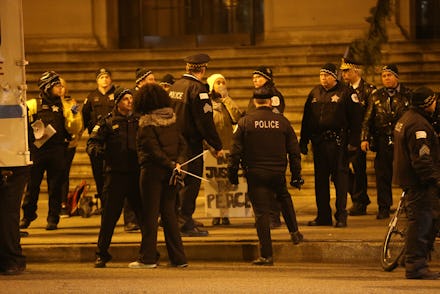Chicago Police Warehouse Used "Extraordinary Rendition" on American Citizens

At first, you might mistake the nondescript building in Homan Square for any other Chicago warehouse. But according to a startling new investigation by the Guardian's Spencer Ackerman, it's actually an "off-the-books interrogation compound" run by the Chicago Police Department that has more in common with CIA black sites (used to extract information from terrorism suspects) than a regular police facility.
What the Guardian found: At Homan Square, suspects go in, but their presence isn't documented. Lawyers find that their clients simply can't be reached, or that the police won't acknowledge they are in police custody. Chicago civil-rights attorney Flint Taylor told the Guardian that the facility is used to coerce and extract confessions out of prisoners, sometimes using physical force.
"This Homan Square revelation seems to me to be an institutionalization of the practice that dates back more than 40 years of violating a suspect or witness's rights to a lawyer and not to be physically or otherwise coerced into giving a statement," Taylor said.
The Guardian alleges that detainees at Homan Square have been kept out of official booking databases, deprived of contact with their attorneys, shackled for prolonged periods and beaten by Chicago police officers. Detainees as young as 15 had been held for 12 to 24 hours without legal counsel. If that weren't terrible enough, "one man was found unresponsive in a Homan Square 'interview room' and later pronounced dead."
NATO summit protester Brian Jacob Church told Ackerman that when he and 11 other activists were arrested in May 2012, Church found himself interrogated while shackled to a bench for 17 hours without being read his Miranda rights. Five lawyers claimed that they had either been denied access to the facility after learning their clients were there or knew of it as a place where suspects were hidden from their counsel in violation of the Fifth and Sixth amendments.
It's a prison for people who haven't been convicted of anything. The Guardian's report suggests that the facility is routinely used to break suspects before they have a chance to exercise their constitutional rights. Following mass protests in response to grand jury decisions that failed to indict police officers in the deaths of two unarmed black men earlier this year, which featured the arrests of protesters across the country, this is cause for grave concern for those who fear the militarization of American police.
Chicago Justice Project executive director Tracy Siska told the Atlantic that the facility brings tactics from the war on terror down on "black and brown and poor kids who can't afford to hire private counsel."
"Ninety-nine percent of the people from this site are involved in some form of street crime: gang activities, drugs — urban violent crime," Siska said. "That's what makes the site even worse. It takes Guantanamo-style tactics on urban street criminals and shreds the Bill of Rights." He added that, until a year ago, loopholes in the police bureaucracy enabled officers to shuffle around detainees to sites like Homan Square without their arrest records appearing in the central database.
"Do these types of practices sound familiar to you?" asked TechDirt's Timothy Geigner. "Would it help if the detainees were in orange jumpsuits and had the tan of a Cuban sun upon their skin?"
In a statement to MSNBC, the CPD said: "The Chicago Police Department has zero tolerance for misconduct and has instituted a series of internal initiatives and reforms to ensure past incidents of police misconduct are not repeated."
Homan Square isn't just a detention facility: Other facilities in the compound include surveillance rooms, anti-gang and anti-vice squad headquarters, as well as evidence and recovered-property storage.
A police officer with CPD's media relations team told Mic that the Homan Square facility did not differ from other precincts operated by the department, but noted that it was often used by undercover police officers who needed to maintain their cover and held other police facilities, including a ballistic lab. The spokeswoman also said that persons detained at the compound were treated identically to those held at other department properties and claimed it was open to the public to recover stolen property.
The Chicago Police Department did not reply to Mic's follow-up questions, including whether the "past incidents of police misconduct" that CPD referred to in their statement to MSNBC were related to past incidents or practices at Homan Square. The Chicago branch of the National Lawyers Guild did not respond to a request for comment.
Why you should care: If you're concerned about police militarization, civil rights or the integrity of the justice system, a place like Homan Square is a terrifying vision of what happens when those issues are ignored by those in power. If Ackerman's allegations are correct, suspects at Homan Square were railroaded into giving confessions under both severe physical and mental coercion.
These heavy-handed tactics are linked to other aggressive policing strategies, such as the increased use of SWAT teams, military-style weaponry and invasive surveillance techniques by law enforcement agencies across the country documented recently by the ACLU. In November 2014, the U.N. Committee against Torture released a report harshly criticizing American police for military-style interrogations, disregarding the rights of citizens and excessive violence during pursuit and arrest of suspects. Reuters reported that panel member Alessio Bruni singled out Chicago's police for "reported current police violence in Chicago especially against African-Americans and Latino young people."
"I've never known any kind of organized, secret place where they go and just hold somebody before booking for hours and hours and hours," retired D.C. homicide detective James Trainium told Ackerman. "That scares the hell out of me that [it] even exists or might exist."